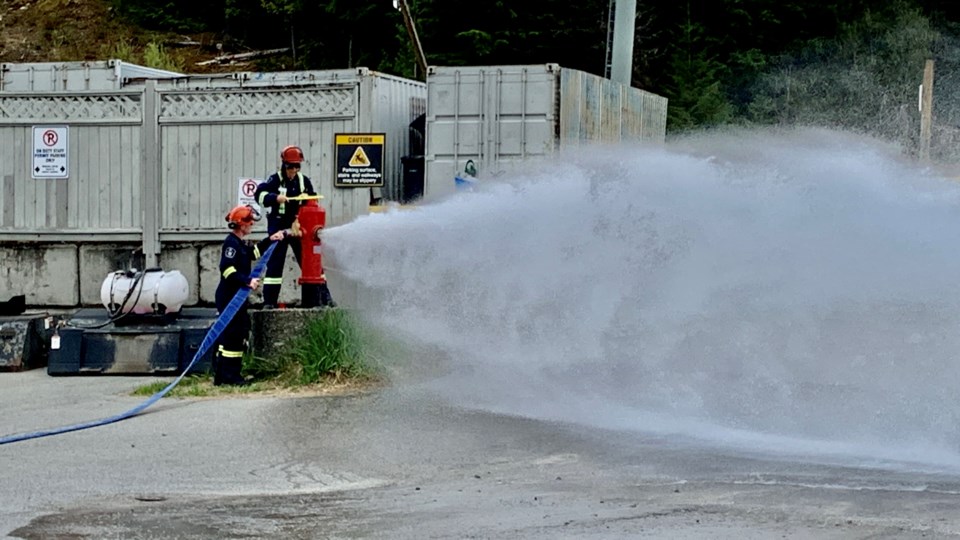With Whistler still seeing some springtime snow dustings, it might not feel like the fire season is right around the corner.
But with temperatures creeping upwards throughout the Sea to Sky region, local and provincial fire services are preparing for another busy season.
“The shoulder season is when our crews work on their training, which includes course training and improving certifications,” BC Wildfire Service (BCWS) spokesperson Julia Caranci said.
“It also includes physical training, which is a very important part of the job. So that’s what we’re doing as we’re ramping up our staff and preparing for fire season.”
Staffing-wise, the BCWS is well prepared for the coming fire season, with all summer crews now onboarded in the Coastal Fire Centre region. The number of firefighters has increased by 55 in 2023 for a total of 315 staff.
“We’re continuing to increase our capacity,” Caranci said.
“Of course, we’re also moving towards assisting with other types of emergencies. So that’s part of the reason, but the main point is that our crews are ready. They’re prepared and ready for whatever fire season brings to us this year.”
Locally, the Whistler Fire Rescue Service (WFRS) aims to retain about 60 paid-on-call members spread across the three fire stations in Whistler, and currently has about 50 members—so it is actively hiring more people.
“We have a recruitment campaign just launched right now … [we’re] hoping to bring on some more firefighters here to help support and get us up to our numbers,” WFRS chief Thomas Doherty said.
How are fire conditions looking?
As of mid-April, the Whistler region is in good condition, as recent snow and rain have dampened the surrounding forests. However, several areas have continued to experience persistent drought across the coastal region, according to Caranci.
“The elevated drought conditions that took place, particularly during the fall of last year in 2022, will persist, generally in most areas of the coastal centre, more inland than on the coast,” she said.
“We’re expecting to see those drought conditions persist until we have a significant and prolonged period of precipitation. Again, more so in the Interior than out on the coast. It’s kind of early yet in the season, and difficult to predict what this year’s fire season will ultimately look like on the coast.”
Generally speaking, the months of May and June are some of the wettest on the coast, so if those months are dry, BCWS expects a busier fire season. If May and June are wet, then there will likely be a more moderate fire season.
So far in 2023, 35 wildfires have popped up across the province, 15 of which occurred in the last week, though none were in the coastal region. Two of these fires were in the Squamish-Lillooet Regional District (SLRD): one in the Bridge River Region and another just south of Lillooet.
Although campfires are currently allowed on Crown land and in B.C.’s parks, BCWS encourages people to be cautious when using open fire whether or not conditions are dry or there are prohibitions in place.
“We want residents to understand that the majority of the wildfires that we experience in the spring are caused by people, and therefore are completely preventable,” Caranci said.
Preparing a strong defence
One of the significant objectives WFRS aims to achieve this year is the creation of a Community Wildfire Defence Plan (CWDP). The plan will help address Whistler’s 32 Community Wildfire Resiliency Plan recommendations and specific areas like policy improvements and ways to encourage homeowners to act on their properties.
“Some of the things that we’re looking at addressing [in the defence plan] are policy improvements around our wildfire development permit areas, and also some policy that gives us a little bit more tools to address property owners taking action to mitigate their hazards on their private lands,” Doherty said.
The defence plan will focus on a range of planning initiatives, such as improvements to water infrastructure and delivery systems across the community, and developing structure defence plans for all the areas of Whistler. Structure defence plans are typically done by the BCWS when a wildfire is threatening a community, but WFRS wants to be proactive.
“We’re going to do that proactively and have those plans done well in advance, [so] if a wildfire does come through our community, [we’re prepared],” Doherty said.
“We’re also going to be looking at identifying different safety locations throughout the community for ground crews, firefighters, and also identifying any other hazards that might be out there, such as specific bridge weight restrictions that might hinder response, and any hazardous materials that may be stored through the community in different areas.”
The WFRS also plans to do more cross-training this year with BCWS and Whistler Blackcomb, reviewing equipment and resources and implementing fuel management work in high-risk neighbourhoods.
“Our focus right now is to continue to maintain doing all our fuel mitigation work, to educate the public on what they can do to help, and prepare,” Doherty said.
To learn more about the FireSmart program, check out firesmartbc.ca or whistler.ca/firesmart.




